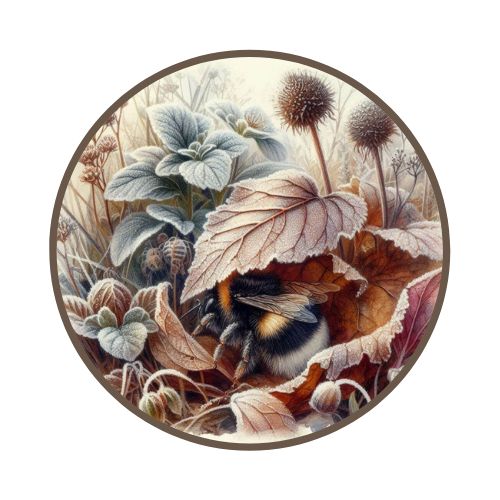Gardens are wonderous ecosystems where the destinies of plants, bugs, and fungi intertwine in a harmonious dance of life. Each element plays a crucial role, creating a balanced and thriving environment. Plants provide food and shelter, while bugs such as bees and butterflies pollinate flowers, ensuring the continuation of plant species. Fungi work behind the scenes, breaking down organic matter and enriching the soil with essential nutrients. This intricate web of interactions showcases the remarkable synergy and interdependence within nature, highlighting the delicate balance that sustains the beauty and vitality of gardens.
The theme for our 2024 Almanac was Kismet. Kismet is the idea of fate or destiny. It is often used to describe the belief that certain events in one’s life are predetermined and beyond individual control. The term is derived from the Turkish word "kısmet," which means "portion" or "fate." On a deeper level, kismet encompasses the notion that life is influenced by a higher power or cosmic order that directs personal journeys and relationships. People often use the term to express the feeling that unexpected events or encounters are meant to happen or are guided by destiny. Kismet symbolizes the interconnectedness of events and experiences that shape a person's life. It embodies the idea of serendipity, where moments of chance can lead to significant outcomes. In literature and storytelling, kismet can serve as a narrative device to illustrate how characters’ lives are entwined by forces beyond their control, reinforcing themes of fate, love, and the unpredictability of life.
Gardens and ecosystems are intricate systems that reflect the principles of interconnectedness. Both serve as microcosms of natural environments, offering insights into how organisms interact, compete, and coexist. We wanted to highlight the importance of interaction between plants, bugs, fungi, and trees for each season.
Winter:
Plants
Longer nights and colder days trigger a slowdown in photosynthesis and respiration in plants, signaling them to go into their dormant state, just like bears slowing their metabolism in time for hibernation. Even evergreen plants that keep their leaves will slow their growth and conserve resources.
Under a protected layer of snow and mulch, plants use up the sugars they store during the summer and use this energy to strengthen roots, bulbs, rhizomes, etc.
Above the soil, the trees have three ways of preventing frost damage:
- Trees will make their cell walls more pliable, allowing the water from within the cell to occupy space between the cells, and as the water expands, the cells shrink and occupy less space.
- A tree will convert starches to sugars, and this thicker fluid acts as a natural antifreeze for the trees.
- Due to the first two mechanisms, trees can supercool their cells to avoid crystallizing.
Early cold snaps can freeze the water in the cells before the tree can prepare, which could lead to the death of part or all of the tree. Keeping cells alive in winter is key to the survival of trees.
- Written by Melissa C.
Bugs
Have you ever wondered where bugs go in the winter? Well, it depends on the bug! Some species of butterflies, beetles, moths, and dragonflies will migrate and follow the heat like monarchs. Some insects only have a year or less life cycle, but their larvae can survive the cold and then hatch in the springtime. Crickets, some spiders, grasshoppers, and praying mantes have this life cycle. The rest do their own form of hibernation called diapause. When temperatures drop, it triggers those who do go into diapause to start eating more to store nutrients. Then they will find a safe place for wintering, and once in place, their metabolism will slow down until the temperatures start warming back up. When extreme freezing temperatures happen, species like the wooly bear caterpillar will produce antifreeze proteins such as glycerol, preventing the water in their bodies from turning into ice crystals and killing them. Colony insects like ants and honeybees will seek safe harbor in their nests and can even seal themselves off from external dangers. Many other bugs seek shelter in micro-habitats and will use things like logs/trees/stumps under the soil, and even in plant galls or swellings in the external tissues of plants.
To support insects in the winter, leave them alone, and come springtime, give them a little extra time to wake up or hatch before cleaning up leaf litter.
- Written by Shae B.
Fungi
Winter is a season of tranquility when nature rests beneath a snowy blanket. And in this serene setting, fungi reveal their own intriguing tales. Let us journey through the fascinating world of winter fungi, where hidden wonders await.
- As winter paints the landscape white, some fungi emerge to claim their snowy kingdom. These unique mushrooms, aptly named "snow mushrooms," thrive in cold and moist conditions. They pop up on fallen branches and tree stumps and are often buried in the snow. With their delicate structures contrasting against the winter backdrop, they add a touch of enchantment to the frosty scenery.
- Winter brings frigid temperatures, and certain fungi enthusiastically embrace the icy conditions. These frost-loving fungi, also known as psychrophiles, have adapted to thrive in extreme cold. They can withstand freezing temperatures and continue their life cycles, even under layers of ice or within frozen soil. It's a testament to the resilience and adaptability of these incredible organisms.
- Winter serves as a stage for fallen trees' slow and beautiful decay. Fungi play a crucial role in breaking down dead wood and recycling its nutrients into the ecosystem. The intricate network of fungal hyphae weaves through the icy wood, transforming it into a rich humus that nourishes the forest floor. Witnessing this delicate dance between fungi and fallen trees reminds me of life's cyclical nature.
Soil Care
The winter months can be harsh on the ground and the symbiotic relationships between plants, animals, and fungi. While nature does its thing and covers the ground with snow, many things are happening under the snowpack that helps your garden thrive in the springtime, so we've collected a few tried and true methods for helping you keep your crops healthy in the winter:
- Mulching: Applying a layer of organic mulch to your garden beds before or during winter helps protect the soil from erosion, weed growth, and nutrient leaching. Mulch acts as a barrier, insulating and keeping the soil at a more consistent temperature. It also breaks down over time, adding organic matter and nutrients to the soil.
- Groud-Cover Cropping: Planting ground-cover crops in your garden during winter is an excellent way to improve soil health. Ground-Cover crops like winter rye, clover, or hairy vetch can be sown to cover bare soil. These plants help prevent soil erosion, suppress weed growth, and add organic matter when they are eventually combined into the soil in the springtime.
- Composting: Winter is a great time to start or maintain a compost pile. Add kitchen scraps, yard waste, and other organic materials to your compost bin. While the decomposition process may be slower in colder temperatures, the compost will continue to break down and enrich the soil with valuable nutrients. Turn the compost pile occasionally to promote aeration and decomposition. Use your compost in the springtime for fertilizer and soil enrichment.








Leave a comment
All comments are moderated before being published.
This site is protected by hCaptcha and the hCaptcha Privacy Policy and Terms of Service apply.